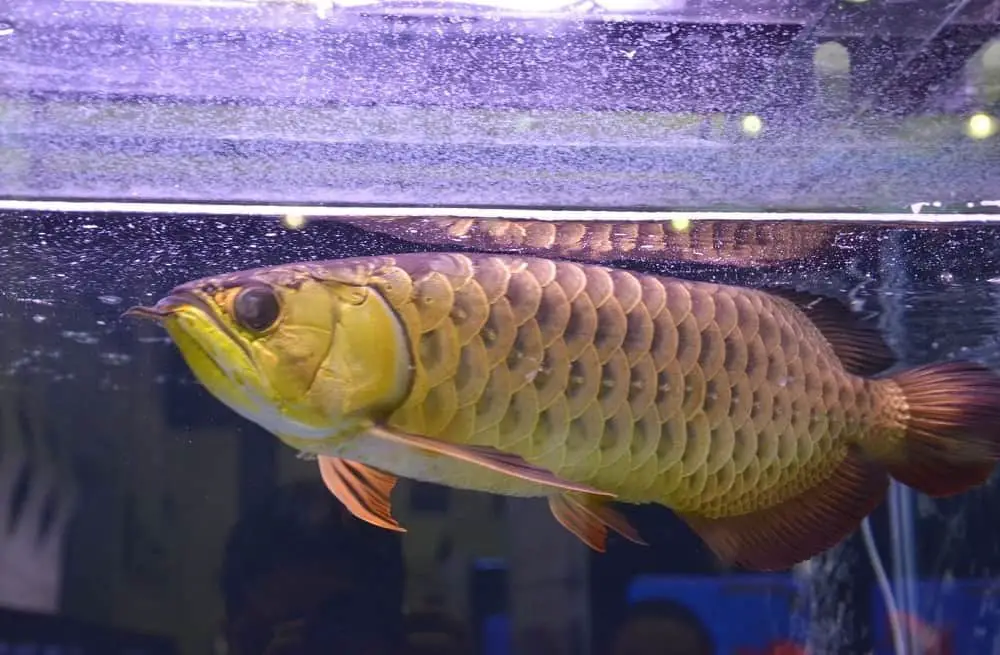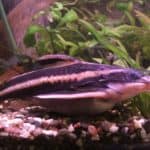The Asian arowana (scientifically known as Scleropages formosus) are a popular aquarium fish that is made of several freshwater phenotypes. Also known as the Asian bonytongue or dragonfish according to the color varieties, the Asian arowana is native to Southeast Asian slow-moving waters.
Asian arowanas are most commonly identified by their signature downturned smiles, making them look permanently grumpy. Not only this, but the species is known for their unique breathing process, where they get oxygen from breathing just at the surface of the water.

Due to their conservation status (Endangered), it is currently illegal to own an Asian Arowana in the United States unless an international agreement between governments has been made, otherwise known as CITES (Convention on International Trade in Endangered Species of Wild Fauna and Flora).
Care Guide
If you can legally own an Asian arowana for the sake of protecting their Endangered conservation status, here is the ultimate care guide to the unique fish!
Tank Size
Asian arowanas can grow up to 4 feet long (depending on the exact species you have), so you will need to find a tank that can hold at least 250 gallons of water. Juveniles will need a 60-gallon tank until they grow big enough for a larger tank.
The bottom of the tank should be covered with bare or fine gravel, as well as aquatic plants around the edges. Arowanas love to swim, so make sure to allow them enough room to swim freely without bumping into plants!
Also, Asian arowanas are known to jump out of the water if they are stressed, so ensure to put a heavy cover over the tank.
Tank Mates
The Asian Arowana is a predator fish, so it’s hard to find tank mates that the arowana won’t try to attack. On the other hand, juvenile Asian arowanas can be bullied by other fish.
The best tank mates for an Asian arowana are other Asian arowanas – but only if you raise them as juveniles. You can keep up to six of the juveniles, and they won’t be aggressive with one another.
Other potential tank mates include:
- Catfish
- Knife fish
- Oscars
- Green terror
- Angelfish
- Parrot cichlid
Just make sure that the fish aren’t so small that the arowana will be able to eat them! We recommend avoiding tank mates for an Asian arowana, however, due to their aggression levels.
Same Species Tanks
The Asian arowana isn’t a fan of tank mates, unless the tank mates are of the same species. If you raise Asian arowanas in a group of six in the same tank as juveniles, they will grow to enjoy each other’s company and won’t be aggressive. It’s not recommended raising them separately as adults, as they can be very territorial.
Water Parameters
When owning an exotic fish, it’s vital that you try to replicate their natural environment as best as you can. Asian arowanas naturally live in warm, soft, acidic water environments, which is something you must replicate in their tanks!
The ideal water requirements for an Asian arowana are:
- Temperature: 75-86 °F
- Hardness: 2-8 dGH (degrees of general hardness)
- Water acidity: 6.0-7.5 pH
The Asian arowana can adapt to water changes, but we recommend committing to 25% water changes weekly.
What To Put In Their Tank
Asian arowanas are notoriously powerful swimmers. This means that anything you put in their tank should be sturdy enough to withstand this power. Sturdy rocks and driftwood are excellent for this – plus these items help to replicate the arowana’s natural environment (and they make the tank look great!).
Aquatic plants are excellent for Asian arowanas, but make sure to find sturdy plants that won’t be easily knocked over. We recommend securing the plants with rocks and driftwood to ensure they don’t fall over. Floating aquatic plants are not ideal as they will clog up the surface of the water, which will prevent the fish from getting their oxygen.
Common Diseases
The Asian arowana is a hardy fish, but poor water conditions can lead to a variety of illnesses and diseases. Fungal infections, barbels’ infection, fin rot, fish lice, and dropsy are common diseases that are mostly caused by poor water conditions. This is why you must provide your Asian arowana with the appropriate environment and diet to keep these diseases at bay.
The chance of these diseases are multiplied in a tank filled with more than one fish, especially if the species are varying. Due to their conservation status and value, it’s imperative that you take your fish to the vet when you notice something’s not right.
Food & Diet
Asian Arowanas are carnivores (and often omnivores). Their diets mostly consist of snails, frogs, snakes, small fish, small mammals (like rabbits), and large insects. As this is what they would naturally eat in the wild, owners must replicate this diet in their tanks.
Of course, you can’t just buy frogs and snakes from a pet store. You should feed your Asian arowana a mixture of shrimp, crickets, earthworms, beef heart, crustaceans, krill, and crabs. Feeder fish are a good option to allow your Arowana to hunt for their prey in their tank.
Lifespan
It is unclear as to what the average lifespan of an Asian arowana in the wild is due to their conservation status. As the species is so highly sought after in the exotic fish pet trade, it’s hard to say how long they live in the wild.
In captivity and in tanks, however, the Asian arowana is said to live up to 15 years. This is one of the reasons why they are so highly sought after!
Appearance
The Asian arowana is a medium to large freshwater fish that has a distinctively long and slim body. From the side, these fish are shaped slightly like rectangles. The scales are shaped like coins, which is why the Asian arowana is considered a sign of good luck in Chinese culture.
There are several color variations of the Asian arowana fish, including reddish scales (hence the nickname of dragonfish), gold, silver, gray, yellow, and green. These variations are said to be due to geographical adaptations.
Along with their long bodies, the Asian arowana has long pectoral, anal, and pelvic fins that contribute to their powerful swimming skills. The dorsal fin, in contrast to the other fins, is very short.
The most distinctive feature of the Asian arowana is their upturned mouths. This mouth shape is there for a reason – these fish have a bony tongue with most of their teeth either on the roof of their mouth or on the tongue. The upturned mouth provides a trapdoor for prey, making it easier to eat.
Size
The average size of an Asian arowana is 35” (roughly 3 feet) in length, though some have been recorded to grow up to 4 feet long. This species shows its health and happiness through its size, so the larger the fish, the happier they are! Due to their large size, the Asian arowana requires a suitable tank size that can accommodate their swimming patterns.
Behavior & Temperament
Asian arowanas are generally a laid-back, relaxed fish that likes to swim around its environment by itself or with a small group of the same species. However, male Asian arowanas are highly territorial, which means they can become incredibly aggressive towards other fish.
This species also has an interesting behavior when it comes to feeding. Despite common logic, the Asian arowana will avoid overeating as this can lead to a loss of appetite and problems with breeding. Therefore, despite its size, this species doesn’t need to eat much food to be healthy.
Breeding
Asian arowanas don’t reach sexual maturity until they are about 3 to 4 years old. The female will produce between 30-100 large eggs, which are then carried in the male’s mouth (as their mouths are larger than the female’s). The male will carry these eggs for around a week, but he will also be protective of his young for another two months.
It’s not recommended breeding an Asian arowana in a tank. Instead, they should only breed in professional breeding farms or in the wild.
Gender Differences: Male vs Female
Asian arowanas are sexually monomorphic, which means it’s hard to distinguish the sexes due to lack of physical differences. However, the male Asian arowana generally has a larger mouth than the female, which is why he is better suited for mouth breeding.
Fun Facts
- The reason the Asian arowana is illegal to own as a “pet” is because of its conservation status. The more fish in captivity means the fewer fish in the wild, which can lead to extinction. Also, as males are mouth breeders, people will kill the male with a knife to collect the fry, which contributes to the declining figure of the species.
- Brightly colored Asian arowanas are very expensive – often costing between $150,000 to $300,000 per fish!
- Another reason why it’s illegal to own an Asian arowana is because if the fish were to be released into American freshwater environments, the species would affect the ecosystem.








